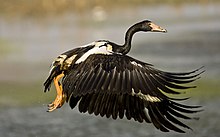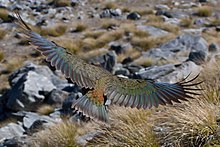Flight is the main mode of locomotion used by most of the world's bird species. Flight assists birds while feeding, breeding and avoiding predators.
This article discusses the mechanics of bird flight, with emphasis on the varied forms of bird's wings. The specifics of hovering, take-off and landing are also examined. Additional adaptations of bird's bodies relating to their flying ability are covered. Finally, theories on the evolution of bird flight.
 Contents [hide]1 Basic mechanics of bird flight
Contents [hide]1 Basic mechanics of bird flight 1.1 Lift
1.2 Gliding
1.3 Flapping
1.4 Drag
2 Wing
3 Wing shape and flight
4 Hovering
5 Take-off and landing
6 Adaptations for flight
7 Evolution of bird flight
7.1 From the trees down
7.2 From the ground up
7.3 Wing-assisted incline running
7.3.1 Pouncing Proavis model
7.4 Uses and loss of flight in modern birds
8 See also
9 Notes
10 References
11 External links
Basic mechanics of bird flight Life
The fundamentals of bird flight are similar to those of aircraft. Lift force is produced by the action of air flow on the wing, which is an airfoil. The lift force occurs because the air has a lower pressure just above the wing and higher pressure below.
When gliding, both birds and gliders obtain both a vertical and a forward force from their wings. This is possible because the lift force is generated at right angles to the air flow, which in gliding flight comes from slightly below the horizontal (because the bird is descending). The lift force, therefore, has a forward component that counteracts drag.
Flapping
 When a bird flaps, as opposed to gliding, its wings continue to develop lift as before, but the lift is rotated forward to provide thrust, which counteracts drag and increases its speed, which has the effect of also increasing lift to counteract its weight, allowing it to maintain height or to climb. Flapping involves two stages: the down-stroke, which provides the majority of the thrust, and the up-stroke, which can also (depending on the bird's wings) provide some thrust. At each up-stroke the wing is slightly folded inwards to reduce upward resistance. Birds change the angle of attack between the up-stroke and the down-stroke of their wings. During the down-stroke the angle of attack is increased, and is decreased during the up-stroke.
When a bird flaps, as opposed to gliding, its wings continue to develop lift as before, but the lift is rotated forward to provide thrust, which counteracts drag and increases its speed, which has the effect of also increasing lift to counteract its weight, allowing it to maintain height or to climb. Flapping involves two stages: the down-stroke, which provides the majority of the thrust, and the up-stroke, which can also (depending on the bird's wings) provide some thrust. At each up-stroke the wing is slightly folded inwards to reduce upward resistance. Birds change the angle of attack between the up-stroke and the down-stroke of their wings. During the down-stroke the angle of attack is increased, and is decreased during the up-stroke.Drag
Apart from its weight, there are three major drag forces that impede a bird's aerial flight: frictional drag (caused by the friction of air and body surfaces), form drag (due to frontal area of the bird, also known as pressure drag), and lift-induced drag (caused by the wingtip vortices). These forces are reduced by streamlining the bird's body and wings.
Wing The bird's forelimbs, the wings, are the key to bird flight. Each wing has a central vane to hit the wind, composed of three limb bones, the humerus, ulna and radius. The hand, or manus, which ancestrally was composed of five digits, is reduced to three digits (digit II, III and IV or I, II, III depending on the scheme followed[1]), which serves as an anchor for the primaries, one of two groups of flight feathers responsible for the wing's airfoil shape. The other set of flight feathers, behind the carpal joint on the ulna, are called the secondaries. The remaining feathers on the wing are known as coverts, of which there are three sets. The wing sometimes has vestigial claws. In most species these are lost by the time the bird is adult (such as the highly visible ones used for active climbing by Hoatzin chicks), but claws are retained into adulthood by the Secretary Bird, screamers, finfoots, ostriches, several swifts and numerous others, as a local trait, in a few specimens. The claws of the Jurassic theropod-like Archaeopteryx are quite similar to those of the Hoatzin nestlings.
Albatrosses have locking mechanism in the wing joints that reduce the strain on the muscles during soaring flight.


No comments:
Post a Comment